Back Squat vs Front Squat
Which type of squat is more effective? Sports scientist Ross Edgley weighs up the options

This article was first published in July 2012. It was updated in 2022 to improve the formatting.
The squat is considered by many experts to be the single best exercise for boosting strength, power and size. But which variation is better: the front squat or the back squat? To find out, we asked Ross Edgley, sports scientist at Myprotein.com, to compare them by examining the muscle activation patterns and movement mechanics of each type.
Weight Lifted
A study at the University of Florida studied muscle activation in 15 trained and experienced athletes as they performed both types of squat at 70% of their one-rep max for three reps. The study uncovered that although the athletes were able to lift 19kg more during the back squat, there was no significant differences in muscle activation of the quads, hamstrings or erector spinae muscles.
Winner: Back squat (marginally)
Injury risk
The same study at the University of Florida found the additional load (19kg) during the back squat increased compressive forces during the lifts, making athletes more prone to injury. This led the researchers to conclude the front squat is better at maximising overall muscle recruitment while minimising injury.
Winner: Front squat
Glute activation
One of the most important muscle groups in the lower body for sport is the gluteal muscles (the gluteus maximus muscle, gluteus medius muscle and gluteus minimus muscle) since they are involved in almost all lower-body movement, either as producers or stabilisers of movement. Australian research found that the wider stance usually used during a back squat was better able to activate the gluteal muscles than the narrower stance of the standard front squat.
Get the Coach Newsletter
Sign up for workout ideas, training advice, reviews of the latest gear and more.
Winner: Back squat
The results are in… The back squat edges it here because it allows you to go heavier and activates more muscle fibres. However, you need to include both in your routine if you want to hit all the muscle groups in your legs effectively. Just remember to start light and get your form correct before you start pushing up through the weights.

Ross Edgley wrote for Men’s Fitness UK (which predated and then shared a website with Coach) when he was a sports scientist, working for brands such as Myprotein. Edgley went on to perform a series of physical feats, including swimming all the way around Great Britain in 157 days. He has written the books Blueprint: Build a Bulletproof Body for Extreme Adventure in 365 Days, The World's Fittest Book and The Art of Resilience, as well as contributing to publications such as GQ.
